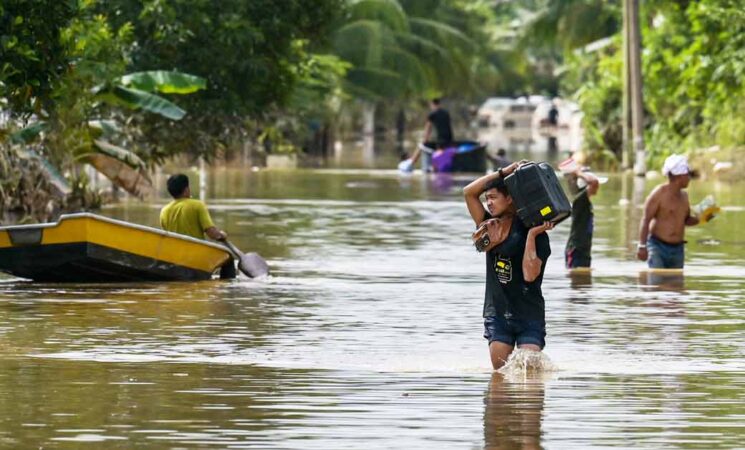10 March 2025, NIICE Commentary 9975
Anoushka Kashyap
Malaysia is a Southeast Asian nation located above the Equator. It is a small nation made up of two regions, named ‘West Malaysia’ and ‘East Malaysia’. It lies in the middle of the South China Sea which is a flashpoint along with the Taiwan Strait and the Korean Peninsula. It has a tropical type of climate as it is hot and humid which is a suitable climate for the vegetation of Malaysia as there is abundant rainfall in the country. It has a land covered with forests and a coastline with a mountain range as well. The economy of Malaysia is mainly agriculture-based due to the diverse and thick rainforests with plant-based products like palm oil, timber, and rubber but they have deteriorated in number due to the draughts and floods in the country which are the causes of global warming. The twenty-first century is a challenging period with the global landscape being exposed to geopolitical conflicts like pandemics and climate change.
The latter is a major concern with devastating effects and many parts of the world are facing a major crisis due to its spillovers. The world is being gradually exposed to this climate crisis and its effects can be witnessed through deteriorating flora and fauna, lack of food and other resources, and water scarcity. Climate Change is a result of the overuse of natural resources, excess deforestation, global warming, and the making of industrialized products that release harmful chemicals and gases to the Earth. Rising temperatures, rising sea levels, extreme weather conditions around the world like extreme summers and extreme winters and unexpected rainfalls are all a byproduct of exploitation and overuse of natural resources.
It is important to mention the Kyoto Protocol, which was devised in 1997 and came into force in 2005. Its mandate was to address the first world or urbanized countries on limiting their greenhouse gas emissions as some of these states release heavy amounts of pollutants into the atmosphere that affect the environment.
Malaysia has been regarded as the fourth largest producer of greenhouse gases in ASEAN (Association of Southeast Asian Nations) contributing to nearly “0.52% of the world’s carbon emissions”~ HA Rahman. There are floods and draughts that are occurring frequently in the country. Malaysia has rich biodiversity but there are rapid changes in the temperature patterns, rainfall, and rising sea levels. The differing levels of rainfall patterns in the country have led to droughts and floods.
As per the Global Forest Watch, “Malaysia has experienced significant deforestation between 2002 and 2021, losing 2.77 million hectares of primary humid forests, which constitutes 33 percent of the total tree cover loss during the same period.” Agriculture which is the main mode of economy in Malaysia is also being affected due to the climate changes leading to crop failures due to extreme heat. The main climate change issues Malaysia is facing include rising sea levels, crop failures, warming waters, erosion of soils, droughts, and floods. Malaysia uses the (Global Climate Model) also known as GCM showing the moving temperatures in the country from 0.7 to 2.6 degrees according to Haliza Rahman.
Causes for Climate Change in Malaysia
It is recorded that both the regions that make up Malaysia are experiencing different problems in Climate Change Peninsular Malaysia is experiencing higher temperatures as compared to East Malaysia. For instance, the East Malay region, in terms of the rainfall, it is receiving more rainfall than the Peninsular Malaysian regions. These climatic effects are adverse as it’s affecting the Malay people severely because due to a lot of water (rains), people are getting more prone to dengue and different diseases due to excessive heat waves.
Malaysia had a population estimated to be about thirty-two million in 2019 according to World Bank Group. It lies near the Equator which means the climate throughout the year remains humid. The climate is different in West and East Malaysia due to the humid climatic conditions of the country. Climate Change has caused natural disasters in Malaysia like flooding and landslides in the country that have led to erosion of soil leading to the loss of nutrients in the soil that are beneficial for growing plants and various crops.
Climate Change has caused natural disasters in Malaysia like flooding and landslides in the country that have led to erosion of soil leading to the loss of nutrients in the soil that are beneficial for growing plants and various crops. These disasters are an alarm from the Earth warning us about the overuse and misuse of natural resources by humankind. These disasters have led to a drastic decline in the agricultural sector of the country. For instance, excessive rainfalls can destroy the harvests of the farmers and ruin the agrarian economy of Malaysia.
The summers are said to be very hot and wet seasons are said to be filled with rainfall which will in turn affect the people of the country by causing heat strokes and other health-related diseases. It is affecting the employment sector of the population as the main jobs are related to agriculture like rice paddies, rubber, and plantations.
The tourism sector is also said to be affected because the main tourist attractions in this small country are mostly in the coastal areas which are being flooded and filled with landslides. Malaysia has been regarded as a huge contributor to greenhouse gases in the Southeast Asian Region says the University of Nottingham Malaysia.
Malaysia also greatly relies on fossil and renewable energy to run the country and this has been regarded as harmful in the long run as it produces greenhouse gases to use fossil to produce energy. The country has experienced the loss of forests which has led to a rise in carbon dioxide.
The government is spreading awareness in the public and has taken up initiatives to improve their country’s conditions but after a deep analysis, it is felt that there is a need for more focused steps to prevent harm to the environment, locals, and animals the islands of Malaysia as they are resourceful and should remain so untouched mostly and not by the greed of Malay people to extract oils and other plant products to sell it overseas.
Anoushka Kashyap is a Research Intern at NIICE. She has completed her Master’s Graduate in International Affairs from OP. Jindal Global University with interests in regions of Southeast Asia, East Asia, and the Indo-Pacific.

